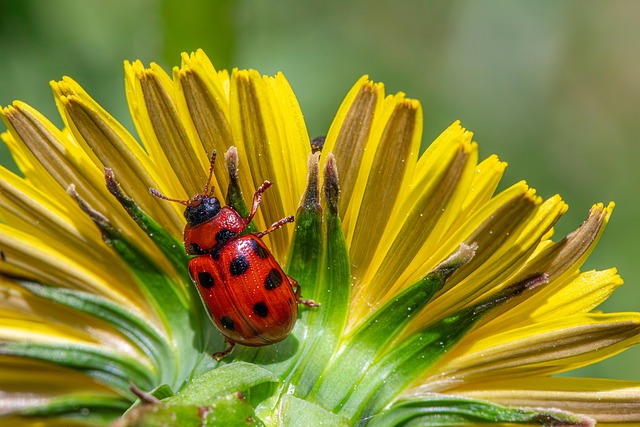Adopt eco-friendly pest treatment solutions for a safer, greener home and garden. Natural methods like essential oils (lavender, peppermint, citronella), diatomaceous earth, neem oil, or soap-water mixtures deter pests without harmful chemicals. These alternatives protect plants, people, and pets while minimizing environmental impact. Companion planting, beneficial insects, physical barriers, and organic traps further support a healthy ecosystem. By choosing natural pest treatments, you contribute to biodiversity and create a healthier living environment.
Looking to create a healthier home and garden without hurting the environment? Discover eco-friendly alternatives to traditional chemical pesticides and embrace sustainable practices. This guide explores natural pest repellent methods for both indoor and outdoor spaces, offering green treatments you can easily integrate into your routine. Learn how to navigate towards more sustainable pest treatment solutions that benefit your family, pets, and planet.
Natural Pest Repellents for Your Home and Garden
Instead of relying on harsh chemicals, consider natural pest repellent methods for a greener approach to maintaining your home and garden. Plants like lavender, peppermint, and citronella are known for their insect-repelling properties and can be cultivated or even diffused indoors to keep pests at bay. Essential oils derived from these plants can also be used in homemade sprays or diffusers, offering an effective yet eco-friendly pest treatment solution.
For a more direct application, try using natural ingredients like diatomaceous earth, neem oil, or soap and water mixtures. Diatomaceous earth, made from fossilized algae, is a non-toxic powder that desiccates and kills insects. Neem oil, derived from the neem tree, is a potent insecticide that disrupts the growth and reproduction of pests. These natural pest treatment solutions are safe for both people and pets while effectively managing unwanted intruders in your living spaces.
Eco-Friendly Alternatives to Chemical Pesticides
Many traditional pest control methods rely on chemical pesticides, which can have detrimental effects on the environment and human health. Fortunately, there are now eco-friendly alternatives that offer effective pest treatment solutions for your home and garden. These natural options not only minimize environmental impact but also promote a healthier living space.
One popular choice is using essential oils, such as neem oil or peppermint oil, which have insecticidal properties. Another approach involves introducing beneficial insects like ladybugs or lacewings to control pests naturally. Additionally, physical barriers like mesh netting or trapping systems can be employed to prevent pest entry. These sustainable pest treatment solutions not only protect your plants and home but also contribute to a greener and more balanced ecosystem.
Sustainable Practices for a Greener Outdoor Space
Creating a greener outdoor space starts with adopting sustainable practices that promote environmental health and biodiversity. Instead of relying on chemical-laden pest treatment solutions, consider organic alternatives. For example, introducing beneficial insects like ladybugs or lacewings can effectively control pests while minimizing harm to the ecosystem. Companion planting, where certain plants are grown together to deter pests naturally, is another eco-friendly method worth exploring.
Utilizing natural repellents and traps also falls under this category. Neem oil, for instance, is a plant-based pesticide that disrupts pest growth cycles without leaving toxic residues. Additionally, simple DIY traps using ingredients like soap and water can capture common garden pests humanely. By embracing these sustainable pest treatment solutions, you contribute to a healthier ecosystem while maintaining a beautiful and chemical-free outdoor space.
Integrating Environmentally Conscious Treatments into Your Routine
Adopting environmentally friendly treatments for your home and garden is a significant step towards creating a healthier living space. This shift involves integrating natural pest treatment solutions into your routine, which not only minimizes the use of harmful chemicals but also promotes biodiversity. Start by identifying the specific pests affecting your environment and research eco-friendly alternatives. For instance, instead of relying on synthetic insecticides, consider using essential oils or plant-based repellents that target common insects like mosquitoes, ants, and spiders.
Regular maintenance plays a crucial role in sustaining these treatments’ effectiveness. This includes keeping your living areas clean, sealing entry points for pests, and maintaining a balanced ecosystem in your garden. By combining natural solutions with good housekeeping practices, you can create an environment that is both welcoming and free from unwanted visitors. These methods not only contribute to the well-being of your family and pets but also play a part in preserving local ecosystems and promoting a greener, healthier lifestyle.
By adopting environmentally friendly treatments, you can create a healthier home and garden while contributing to a sustainable future. The article has explored natural pest repellent options, eco-friendly alternatives to chemical pesticides, sustainable outdoor practices, and seamless integration of these conscious treatments into your routine. Embracing these pest treatment solutions not only protects your living spaces but also conserves the planet’s resources for future generations. Start making a positive impact today with these simple yet powerful changes.
